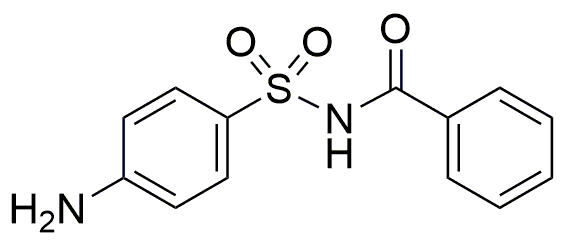Sulfabenzamide is widely utilized in research focused on:
- Pharmaceutical Development: It serves as an important intermediate in the synthesis of sulfonamide antibiotics, which are crucial for treating bacterial infections.
- Agricultural Chemistry: Used in the formulation of herbicides and pesticides, it helps improve crop yield by effectively controlling weed growth and pests.
- Analytical Chemistry: Employed as a reagent in various analytical methods, it aids in the detection and quantification of specific compounds in complex mixtures.
- Biochemical Research: Acts as a tool in studying enzyme inhibition and metabolic pathways, providing insights into drug mechanisms and potential therapeutic targets.
- Material Science: Its properties make it suitable for developing polymers and coatings, enhancing durability and resistance to environmental factors.
General Information
Properties
Safety and Regulations
Applications
Sulfabenzamide is widely utilized in research focused on:
- Pharmaceutical Development: It serves as an important intermediate in the synthesis of sulfonamide antibiotics, which are crucial for treating bacterial infections.
- Agricultural Chemistry: Used in the formulation of herbicides and pesticides, it helps improve crop yield by effectively controlling weed growth and pests.
- Analytical Chemistry: Employed as a reagent in various analytical methods, it aids in the detection and quantification of specific compounds in complex mixtures.
- Biochemical Research: Acts as a tool in studying enzyme inhibition and metabolic pathways, providing insights into drug mechanisms and potential therapeutic targets.
- Material Science: Its properties make it suitable for developing polymers and coatings, enhancing durability and resistance to environmental factors.
Documents
Safety Data Sheets (SDS)
The SDS provides comprehensive safety information on handling, storage, and disposal of the product.
Product Specification (PS)
The PS provides a comprehensive breakdown of the product’s properties, including chemical composition, physical state, purity, and storage requirements. It also details acceptable quality ranges and the product's intended applications.
Certificates of Analysis (COA)
Search for Certificates of Analysis (COA) by entering the products Lot Number. Lot and Batch Numbers can be found on a product’s label following the words ‘Lot’ or ‘Batch’.
Numéro de catalogue
Numéro de lot/série
Certificates Of Origin (COO)
This COO confirms the country where the product was manufactured, and also details the materials and components used in it and whether it is derived from natural, synthetic, or other specific sources. This certificate may be required for customs, trade, and regulatory compliance.
Numéro de catalogue
Numéro de lot/série
Safety Data Sheets (SDS)
The SDS provides comprehensive safety information on handling, storage, and disposal of the product.
DownloadProduct Specification (PS)
The PS provides a comprehensive breakdown of the product’s properties, including chemical composition, physical state, purity, and storage requirements. It also details acceptable quality ranges and the product's intended applications.
DownloadCertificates of Analysis (COA)
Search for Certificates of Analysis (COA) by entering the products Lot Number. Lot and Batch Numbers can be found on a product’s label following the words ‘Lot’ or ‘Batch’.
Numéro de catalogue
Numéro de lot/série
Certificates Of Origin (COO)
This COO confirms the country where the product was manufactured, and also details the materials and components used in it and whether it is derived from natural, synthetic, or other specific sources. This certificate may be required for customs, trade, and regulatory compliance.

